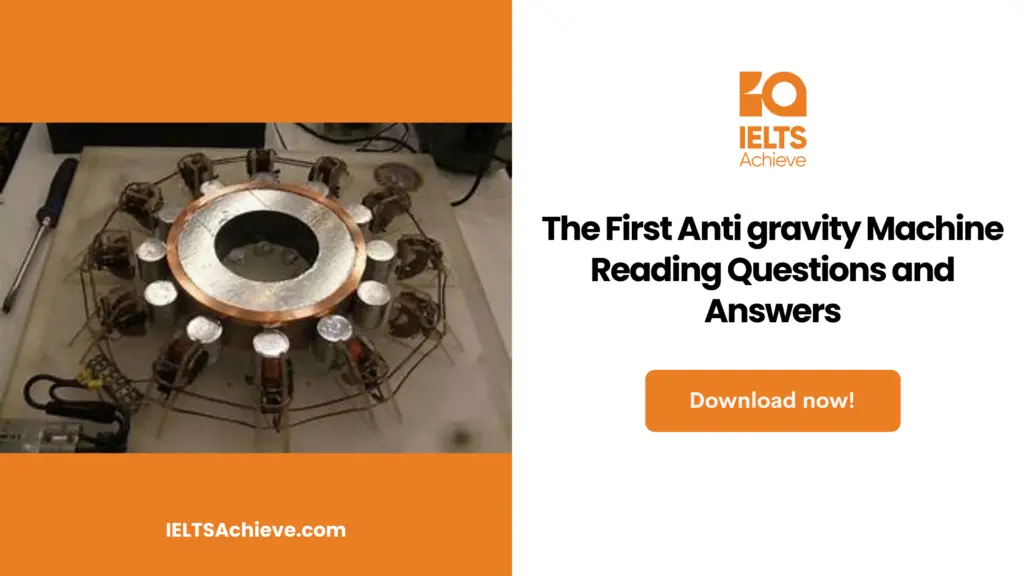The Blog post contains the following IELTS Reading Questions:
- IELTS Reading Diagram Labelling
- IELTS Reading Multiple Choice Questions
- IELTS Reading True/False/Not Given
Stay informed and prepared for success – Explore our comprehensive Reading Test Info page to get valuable insights, exam format details, and expert tips for mastering the IELTS Reading section.
IELTS Reading Passage: The First Anti Gravity Machine

The First Antigravity Machine
A. It was one of the biggest science stories of the 1990s. Even now, the facts behind it remain hotly disputed. And small wonder, for if the claims made for the small disc, the focus of the controversy, are true, it may be possible to break through one of the great barriers in the scientific world and control the most potent of cosmic forces: gravity. Huge innovations in flight and space travel could arise from that.
B. The first gravity-blocking system to be taken seriously by scientists appeared in a laboratory in Tampere University of Technology, Finland. A Russian scientist named Dr. Evgeny Podkletnov created a disc 275mm across, made from a substance which combined copper, barium and the ‘rare Earth metal’ called yttrium, which is known to be a high-temperature superconductor (a substance that conducts electricity without resistance). When chilled with liquid nitrogen at -196° C (a high temperature compared with other superconductors), this material loses all its electrical resistance and can levitate (lift) in a magnetic field. That may seem amazing for a ceramic-like material – and it won a Nobel Prize for the scientists Karl Muller and Johannes Bednorz, who first demonstrated it in the 1980s. But according to Podkletnov, the disc had another far more astounding property.
In 1992, while experimenting with rotating superconductors, Podkletnov noticed that pipe-smoke from a nearby researcher was drifting into a vertical column above the spinning disc. Intrigued by this phenomenon, he decided to devise an experiment to investigate further. A superconductive disc, surrounded by liquid nitrogen was magnetically levitated and rotated at high speed – up to 5,000 revolutions per minute (rpm) in a magnetic field. An object was suspended from a sensitive balance above the disc. It was enclosed in a glass tube to shield it from any effects of air currents. During the course of a series of tests, Podkletnov was able to observe that the object lost a variable amount of weight from less than 0.5 percent to 2 percent of its total weight. The effect was noted with a range of materials from ceramics to wood. The effect was slight, yet the implications were revolutionary: the disc appeared to be partly shielding the object from the gravitational pull of the earth.
C. This was just the start, claimed Podkletnov. While far short of the 100 percent reduction in weight needed to send astronauts into space, for example, it was infinitely greater than the amount predicted by the best theory of gravity currently in existence. Einstein’s theory of general relativity (GR), published in 1905. According to Einstein, gravity is not some kind of ‘force field’ like magnetism, which can – in principle at least – be screened out. Instead, GR views gravity as a distortion in the very fabric of space and time that permeates the whole cosmos. As such, any claim to have shielded objects from gravity is to defy Einstein himself.
Podkletnov’s claims were subjected to intense scrutiny when he submitted them for publication. The UK Institute of Physics had Podkletnov’s paper checked by three independent referees, but none could find a fatal flaw. His research was set to appear in the respected Journal of Physics D when events took an unexpected turn. The claims were leaked to the media, sparking worldwide coverage of his apparent breakthrough. Then Podkletnov suddenly withdrew the paper from publication and refused to talk to the press.
Rumours began to circulate of unknown backers, demanding silence until the device had been fully patented. But for many scientists, the strange events were all too familiar. Podkletnov was just the latest in a long line of people to have made claims about defying gravity. Most of these have come from madcap inventors, with bizarre devices, often with some kind of spinning disc. But occasionally respectable academics have made such claims as well.
D. One instance of this occurred in the late 198Os when scientists at Tohoku University, Japan, made headlines with research suggesting that apparatus known as the gyroscope, lost 0.01 percent of its weight when spinning at up to 13,000 rpm. Oddly the effect only appeared if the gyroscope was spinning anticlockwise – raising suspicions that some mechanical peculiarity was to blame. Attempts by scientists at the University of Colorado to replicate the effect failed.
E. Then Professor Giovanni Modanese, an Italian theoretical physicist, became interested. He had read an earlier paper by Podkletnov, hinting at a connection between superconductivity and gravity shielding. Modenese wondered if the magnetic field surrounding the superconductive disc might somehow assimilate part of the gravitational field under it. He published some calculations based on his idea in 1995 – and soon discovered that taking ‘antigravity’ seriously was a career-limiting move.
F. The revelations about Podkletnov’s antigravity research led to reports of major corporations setting up their own studies. In 2000, the UK defence contractor BAE systems were said to have launched “Project Greenglow” to investigate Podkletnov’s gravity shield effect. Then it emerged that the US aircraft builder Boeing was also investigating, suggesting it too had an interest in the effect. Groups in other countries were also rumoured to be carrying out studies. Yet not one of the teams had reported confirmation of the original findings. Some projects have been wound up without producing results either way. So for the time being, it seems that the dream of controlling gravity will remain precisely that.
Unlock your full potential in the IELTS Reading section – Visit our IELTS Reading Practice Question Answer page now!
Recommended Questions:
Renewable Energy IELTS Reading Question with Answer
Questions
Question 27 – 30
Label the diagram below. Choose NO MORE THAN THREE WORDS AND/OR A NUMBER from the passage for each answer.

27. ______ to measure weight loss
28. ______ superconductive disc rotating at max cooling
29._______
30. _______ to protect object from disturbance
Ready to tackle Diagram Label Completion tasks with confidence? Click here to access our comprehensive guide and learn how to accurately label parts or components of diagrams in the IELTS Reading section.
Questions 31-35
Classify the following findings as belonging to
A Podkletnov
B Tohoku University
C Modanese
Write the correct letter A, B or C in boxes 31 – 35 on your answer sheet. ABC31. The experiment only works if the equipment moves in a particular direction.
31. The experiment only works if the equipment moves in a particular direction.
32. Varying amounts of weight are lost as a result of the test.
33. Gravity could be absorbed by a magnetic field.
34. Superconductive material seems to screen an object from gravity.
35. Weight loss occurs when the equipment rotates at speeds reaching 13,000 rpm.
Ready to improve your performance in Multiple Choice Questions (MCQs)? Click here to access our comprehensive guide on how to tackle MCQs effectively in the IELTS Reading section.
Question 36-40
Do the following statements agree with information given in Reading Passage 3? In boxes 36 – 40 on your answer sheet, write
TRUE if the statement agrees with the information
FALSE if the statement contradicts the information
NOT GIVEN if there is no information on this.
36. Podkletnov won a prize for his initial work on superconductive substances.
37. A chance observation led Podkletnov to experiment with gravity blocking.
38. Einstein challenged earlier experiments on antigravity.
39. Modanese suffered professionally after following up Podkletnov’s findings.
40. An aircraft company announced that it had replicated Podkletnov’s results.
Enhance your skills in identifying information as True, False, or Not Given. Click here to discover expert strategies and techniques for mastering this question type in the IELTS Reading section.
Unlock your full potential in the IELTS Reading section – Visit our IELTS Reading Practice Question Answer page now!
Recommended Questions:
Renewable Energy IELTS Reading Question with Answer
Answers for The First Anti Gravity Machine
27. Answer: (Sensitive) Balance
28. Answer: 5,000 revolutions per minute
29. Answer: Liquid Nitrogen
30. Answer: Glass tube
31. Answer: B
32. Answer: A
33. Answer: C
34. Answer: A
35. Answer: B
36. Answer: False
37. Answer: True
38. Answer: Not given
39. Answer: True
40. Answer: False

We hope you found this post useful in helping you to study for the IELTS Test. If you have any questions please let us know in the comments below or on the Facebook page.
The best way to keep up to date with posts like this is to like us on Facebook, then follow us on Instagram and Pinterest. If you need help preparing for the IELTS Test, join the IELTS Achieve Academy and see how we can assist you to achieve your desired band score. We offer an essay correction service, mock exams and online courses.

